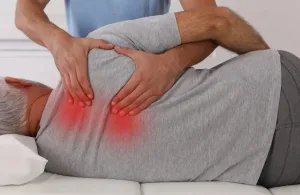Herniated discs are a problem with the discs located in the vertebrae of the spine. These discs are made up of two parts, a tough exterior and a soft center. When that soft center tears through the hard outer shell, the disc is herniated. Herniated discs are also sometimes called ruptured discs, or slipped discs.
Sometimes a herniated disc compresses nerves, which can make them extremely painful. People often find herniated discs debilitating, leaving them unable to work or perform normal daily functions. In other cases, a person may suffer from a herniated disc and not even know it because it does not cause that person any discomfort.
Anyone who suspects a herniated disc should speak to a chiropractor who can help. Even when the herniated disc is not painful, it could throw a person’s entire alignment off, resulting in other problems. Seeing a chiropractic for herniated discs can act as a preventative measure safeguarding against those future issues.
Symptoms of Herniated Discs
Herniated discs most commonly occur within the lower back, although it is possible for discs in the neck to herniate, as well. There are three main symptoms to look for that could indicate a problem with a herniated disc.
- Pain: The first, and most obvious, is pain. Most people expect to feel pain in their back, as that is the location of the disc. This is not usually where the pain shows up, though. When the herniated disc is located in the lower back, the pain is felt mostly in the buttocks, thigh, and calf. It is also possible that the pain could travel down to the foot.When the herniated disc is located in the neck, pain is typically restricted to the shoulder and arm. If you move your neck, the pain could also travel down the arms or legs as the spine also moves.
- Numbness or Tingling: Pain is common with herniated discs, but it is not present in every case. Sometimes people simply have numbness or tingling in certain areas of the body.
- Weakened Muscles: In other instances, herniated discs cause muscles to become weaker. In extreme cases, a herniated disc can cause people to stumble as they walk, or prevent them from lifting or holding anything.
Sometimes people with a herniated disc do not show any of these symptoms. They do not even know about the herniated disc until it appears on an X-ray or during a consultation for chiropractic care.
Can a Chiropractor Diagnose a Herniated Disc?
Chiropractors are very familiar with herniated discs, and they know what to look for when making a diagnosis. During the initial consultation, a chiropractor will perform a physical exam. They will look at the area where the herniated disc is located, along with the entire spine. Chiropractic care encompasses the overall health of the spine, and if something else is wrong, it could cause a herniated disc.
A chiropractor will also test your reflexes if they suspect a herniated disc. If the nerves are not sending messages correctly, the reflexes will not react as they should. This is an indication that a disc is herniated. A chiropractor will also look at the muscles and soft tissue, looking for signs of atrophy or loss of strength.
Of course, a chiropractor will also take into consideration any pain you are feeling and where you are feeling it. This will help determine which nerve, and therefore which disc is affected. Sometimes chiropractors will need to take an X-ray or order an MRI as part of chiropractic care if they cannot pinpoint exactly where the issue is located.
Seeing a Chiropractor for Herniated Discs
If you’re unsure how to treat herniated discs, start with a chiropractor. Chiropractic care is effective in treating herniated discs. Many treatment plans begin with spinal manipulation. This is a hands-on technique the chiropractor will use to gently nudge the disc back into position.
At this point you may hear popping or cracking noises. These are nothing to worry about. As the discs shift, they release gas and this is the sound you are hearing. It is similar to cracking your knuckles and it should not hurt.
After spinal manipulation, people may feel immediately better. Due to the fact that this technique involves slow, gentle movements, it can sometimes take a few sessions before the disc moves back to its proper position and results in significantly reduced pain.
Chiropractors will typically recommend certain herniated disc exercises that can help relieve the pain. Pelvic blocking is an effective exercise that changes the way the body sits, helping to move the disc away from the nerve on which it is pressing. This technique is done by placing two soft wedges underneath each side of the pelvis.
This is just one type of herniated disc exercise, but chiropractors will typically recommend several that can help. These exercises, in conjunction with spinal manipulation, can help treat a herniated disc quickly, so you can move on from the injury.
It is important to understand that if you think you have a herniated disc, you should see a chiropractor. However, while spinal manipulation is effective at treating herniated discs, some patients simply are not good candidates for chiropractic care.
A chiropractor may be unable to help patients who have significantly lost strength or sensation in one part of their body or are experiencing problems with their reflexes. In the worst cases involving herniated discs, surgery is the only way to treat the issue. Chiropractors do not perform surgery, but if they determine you need it, they will refer you to a doctor who can.
Do You Think You Have a Herniated Disc? Call a Chiropractor
Herniated discs can cause real problems, even when you do not know you have one. If you have experienced any of the symptoms associated with herniated discs, contact a chiropractor who can help.
At Excelsia Injury Care, our healthcare professionals want to get you back on the road to good health. We are happy to meet with you to discuss any problems you are having and talk about possible treatment options. Call us at 888-245-8488, or fill out our online form and we will get in touch. You should not have to live with the pain any longer. Contact us today and find out how we can help.



